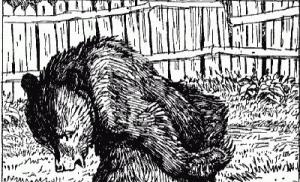Anteater - photo, types, description. Pygmy or two-toed anteater (Cyclopes didactylus)
In fact, very ancient animals, their prehistoric ancestors inhabited our planet in the distant Miocene, and possibly even earlier. Among modern anteaters, scientists distinguish three-toed (Giant
or large anteater
, photo on the preview to the article) and four-fingered (Tamandua
).

Also known pygmy anteaters , separated into a separate family ( Cyclopedidae),

which since Anteater family (Myrmecophagidae) belongs to one suborder. The closest relatives of anteaters are sloths and armadillos.
Anteaters various kinds quite different in appearance. So, the weight of the pygmy anteater is about 400 g with a body length of up to 20 cm, while the giant anteater weighs up to 40 kg, its body length (without a tail!) Can reach 1.2 m. Tamandua anteaters weigh 3-5 kg, length their bodies are 54-58 cm. The tail of the tamandua and the pygmy anteater has a grasping function. On the hind legs, various species of anteaters have 4 or 5 fingers, the fingers on the front legs end in long powerful claws.

All anteaters have relatively big ears, small eyes and a strongly elongated, long muzzle with a tiny mouth opening. The pride of the anteater is its long, narrow and flexible tongue, moistened with sticky saliva,

brothers-smaller.ru
which in the giant anteater reaches a length of 60 cm, the muscles that control the tongue are attached to the sternum in anteaters. The teeth of these animals are completely absent, but the stomach has powerful muscles, like in birds. Also, like birds, anteaters swallow small pebbles - all this helps to grind food. In addition, the anteater partially crushes insects on the hard palate at the time of ingestion, and very aggressive gastric juice contributes to the digestion of food. in different anteaters it varies greatly, in dwarf anteaters it is short and soft, in giant anteaters it is very long and hard.
Mexican tamanduas have special anal glands that, when threatened, secrete a secret with a strong and unpleasant odor, for which these animals received the nickname "forest stinkers".
The habitat of anteaters includes Mexico, the countries of Central America, Bolivia, Brazil, Argentina, Uruguay and Paraguay. The arboreal pygmy anteater and the arboreal-terrestrial tamandua are tropical forest dwellers. Giant anteaters, with their terrestrial lifestyle, can be found in the savannas and pampas, as well as along river banks. Anteaters do not dig holes, but try to choose a quieter place for rest, although a giant anteater can sleep sweetly, curled up and hiding with a fluffy tail, right in the middle of a bare plain - he has practically no enemies in nature. Anteaters are most active at dusk and at night.
Because of the long claws on the front paws, it would be difficult for the anteater to move on the ground, so while walking, he puts his paws a little obliquely, and sometimes he is forced to bend them, leaning on the back of the hand and wrapping it inward. Because of this, the anteater's gait looks like a clubfoot, which does not prevent the animal from moving at a fairly decent speed.
Anteaters, but have excellent hearing and a keen sense of smell. They feed mainly on ants and termites, occasionally including other small insects and their larvae in their diet. The anteater breaks termite mounds and anthills with powerful clawed front paws, making a real mayhem, and launches a long sticky tongue inside, to which prey sticks. During a meal, the tongue of an anteater can make up to 160 movements per minute! In search of food, anteaters also turn over stones and driftwood, and pygmy anteaters find insects in the foliage of trees.
Anteaters are loners by nature, with the exception of the mating season and females with cubs. Anteaters are capable of mating throughout the year, but the mating season most often occurs in autumn or spring-autumn, the male finds the female by smell. Pregnancy in various species of anteaters can last from 3-4 months (pygmy anteaters) to six months (giant anteaters), in tamandua 130-150 days, as a result one, rarely two cubs are born. The newborn anteater immediately climbs onto the back of the mother, clings to the wool and continues to “ride” it for quite some time. long time.

goodnewsanimal.ru
Interestingly, many anteaters, although they can bring offspring in captivity, their cubs are already losing their ability to reproduce.
Young anteaters of various species reach sexual maturity at the age of 1-2 years. The main enemies of anteaters in nature are eagles, boas and Poisonous snakes. On average, the life span of a giant anteater is 15 years, tamandua - 9 years. The number of anteaters in nature is steadily declining, mainly due to the destruction of their habitats, so in many countries they are listed in the Red Book.
Most often, four-toed anteaters-tamandua or pygmy anteaters are kept as pets. However, if you suddenly want to show off such an unusual animal in the house, know that you will have to compete in originality with Salvador Dali himself!

The famous artist not only liked to walk with the giant anteater that lived in the Parisian zoo along the city streets, but also often took him with him to social events.
It should be recognized that anteaters do not show aggression towards humans,

quite easily tamed, and very fond of affection.

brothers-smaller.ru
Connoisseurs say that the anteater can be quite accustomed to the tray, they love active games, they are happy to walk on a leash,

easy to find mutual language and play with other pets:

However, the anteater in the house is far from being one continuous “mi-mi-mi”:

Being quite smart and dexterous, these animals will quickly learn to open any constipation and you will be able to find them in the very unusual place. Left unattended, the anteater will instantly put things in order in the apartment, pulling clothes out of the closet, will not fail to look into the bathroom or even into the refrigerator, will gladly sleep on the laptop keyboard or stick its long nose into your glass:
 rice or oatmeal With raw minced meat from lean meat (veal, beef, chicken). Can be given to anteaters and raw eggs
they need the constant presence of fresh water. You can periodically diversify the menu of a home anteater a mixture of fruits and vegetables with nuts and honey, however, due to the absence of teeth in the animal, all food will have to be given in a pureed form.
rice or oatmeal With raw minced meat from lean meat (veal, beef, chicken). Can be given to anteaters and raw eggs
they need the constant presence of fresh water. You can periodically diversify the menu of a home anteater a mixture of fruits and vegetables with nuts and honey, however, due to the absence of teeth in the animal, all food will have to be given in a pureed form.

animalia-life.club
Of course, such a "diet" cannot be an equivalent replacement for the natural diet of anteaters, perhaps for this reason in captivity they rarely live longer than 6 years.
During the game, the anteater can accidentally injure severely with its long sharp claws. It is highly undesirable to have such an animal in the house with small children. Like cats, anteaters like to sharpen their claws on furniture, wooden doors and windows.
You can buy a domestic anteater only in specialized nurseries; it is absolutely not worth buying smuggled animals "from hand" according to an ad. The price of a cub is very high and reaches 6,000 dollars.

ushilapychvost.ru
Despite the fact that the anteater is a funny and affectionate pet, it is better to think carefully: are you able to provide the animal with comfortable living conditions and is it worth getting involved in this adventure?
The places where the anteater lives are well known to all fans of this animal. It belongs to the genus of edentulous mammals.
Such different anteaters
You can find out where the anteater lives by reading this article. It should be noted right away that there is a wide variety of these animals in the world. From pygmy anteaters, whose weight is less than half a kilogram, and a body length of only 15 centimeters, to a giant anteater. This one grows more than a meter in length, and weighs about three tens of kilograms.
Traditionally, as with most mammals, males are noticeably larger than females. Their main distinguishing feature- long and tube-shaped muzzle, which ends with a small mouth opening, very narrow. At the same time, the ears are very small, and the eyes are just tiny.
The tail of different anteaters is different. For example, a pygmy anteater or a tamandua has a bare tail with a grasping reflex. Anteaters are also distinguished by a worm-like tongue. It is quite long, for them it is a kind of trapping organ. The anteater wets it with sticky saliva. In a giant anteater, such a tongue can be up to 60 centimeters in length. According to this indicator, they are leaders among all land animals on the planet.
The body of this animal is usually covered with thick hair. The hairs are soft and short in small individuals, coarse and long in large representatives of this family. Coloring is the most contrasting. It may be gray, or it may be golden brown. Most four-toed anteaters are characterized by dark stripes, or an extensive black spot across the entire body.
Only at first glance, their skull looks fragile, but in reality the bones are very strong and thick. Anteaters are very similar to armadillos and sloths. The fundamental difference is that they have no teeth at all.
Distribution area

Representatives of this family flooded several continents at once. Where the anteater lives, it is mostly warm and humid. Often this is a zone of tropical forests. This is how you can answer the question, where does the anteater live, in what natural zone?
You can meet these amazing and cute animals all over from Mexico to Central America. And also in Brazil, Bolivia and Paraguay. Where the anteater lives, in what zone, you will learn from this article. To be precise, it's wet. rainforests and grassy savanna.
Most often, when figuring out where the anteater lives, the photo of which is in this article, the researchers note that these are forests in the tropics. But often you can meet him in open spaces. For example, on the banks of rivers in the savannas.
Now you know where the anteater lives, on which mainland. Animals lead a terrestrial lifestyle, however, mainly this applies to the giant anteater. Arboreal way of life in pygmy anteaters. But one of the most common species of four-toed anteaters leads a combined life - both in trees and on the ground.
diet

The period of their activity falls on the dark time of the day. It begins as soon as dusk descends on the earth, and continues throughout the night. The diet of an anteater cannot be called very diverse. Mostly, these are termites or ants. The heroes of our article destroy their buildings with their powerful front paws. After that, they begin to collect insects with a long and sticky tongue.
They occasionally feed on bees or beetle larvae. Anteaters, which are kept in the zoo, allow themselves a more varied menu. For example, they eat fruit. Recall that they have no teeth, so one of the sections of the stomach is equipped with powerful muscles to grind all the food that enters the body. A similar structure of internal organs is observed in birds. So they manage to grind food. This process is enhanced by small pebbles or sand, which anteaters often accidentally swallow.
sense organs

Anteaters have an excellent sense of smell. At the same time, vision and hearing are very weak. They are protected from predators by powerful claws. At the same time, they lead a predominantly solitary lifestyle. In pairs, only females with cubs can be found. Anteaters breed once a year. The female gives birth to one child, who lives on her back for the entire period of infancy.
Interestingly, anteaters appeared on Earth a long time ago. Their fossils are found most often in South America. Approximately from the period of the early Miocene, which began 23 million years ago. Most scientists are convinced that anteaters are even older. True, in Lately their numbers have declined markedly. But they are not included in almost any Red Books.
Four-toed anteater

In order to get to know these animals better, let's focus on one of the most common representatives - the four-fingered anteater. This is a funny and very attractive animal.
The body of this particular anteater has a length of 55 to 90 centimeters. And this is not counting the tail, which reaches up to half a meter in length. The total body weight of individual individuals reaches five kilograms.
This species of anteater is also called the Mexican tamandua, from the name it becomes clear where the anteater lives. He has a curved and elongated muzzle, his mouth is very small in diameter. It is only sufficient to pass the tongue, the length of which, with such body parameters, is really impressive. Tamandua's tongue is about 40 centimeters long.
Like all four-toed anteaters, the tamandua has a tenacious tail, in some representatives it is completely naked, in others it is naked only from below. he himself irregular shape covered with marks of various sizes. Tamandua's eyes are very weak, they see extremely poorly. At the same time, large ears, which almost always stand erect, indicate that this organ plays a big role in their lives. They receive most of the information about the world around them through hearing. On the front paws, they can see four toes with claws on each, and on the hind legs, five claws.
The fur of this anteater is thick and hard, often very bristling. To protect themselves from predators and other detractors, Mexican tamanduas can emit a strong foul odor from their anal glands. This happens when they sense impending danger. For this feature, they were even nicknamed forest stinkers.
Where does the anteater tamandua live?

Specifically, this anteater lives in the forests of the South American continent. It can be found from Trinidad all the way to Venezuela. It lives in the northern part of Argentina, Uruguay, in the south of Brazil. Specifically, Mexican tamanduas are found in Central America. They can be found and photographed even in the southeast of Mexico. natural area where anteaters live are the tropics and savannahs.
Most often they choose forest edges, and at a fairly low altitude - up to two thousand meters above sea level. They like to live near small reservoirs, as well as next to trees - epiphytes and lianas.
Lifestyle

Like other anteaters, four-toed anteaters stay awake at night. V daytime days they are in hollows or burrows. But Mexican tamanduas can be found day and night. They are able to stay awake up to eight hours a day.
Often they eat without even descending from the trees. On the ground they walk little, slowly and clumsily. In this, they are very different from giant anteaters, which are capable of developing very high speeds.
The way they move is interesting. In order not to injure sensitive feet when walking, they move on the outer ribs of the feet. And the clawed front paws are used for self-defense. If it fell out to fight with the enemy on a tree, they tightly clasp the branch with both paws. When they are on the ground, they lean against some kind of support. For example, to a tree trunk or rock. They also have a very funny defensive tactic - fall on their backs and fight back with all four legs. Their main detractors are big snakes, eagles and jaguars.
How long do anteaters live?
Scientists managed to fix the maximum life span of anteaters nine and a half years. Females become sexually mature by the end of the first year of life. Pregnancy lasts four and a half to five months. The only cub is born in spring.
Anteaters feed on termites and ants. They detect them by smell. At the same time, those species that emit caustic and dangerous substances are determined in advance. chemical substances and they are not eaten. They love bees and honey. In captivity, they even agree to meat.
The value of anteaters for humans
Surprisingly, among the Amazonian natives, four-toed anteaters live at home. They are kept to fight termites and ants that enter the dwelling.
And there is value in their tail veins. They make strong ropes.
Nature has created many amazing animals, but the one that will be discussed in the article is at the forefront of this list. The giant three-toed anteater, whose photo is in front of you, is listed in the IUCN Red List.
This is a large animal with a muzzle narrow as a tube, a long tongue and a luxurious thick fur coat. His lifestyle in natural environment as amazing as the looks.
Giant anteater: photo, description
As stated earlier, appearance three-toed representative of the fauna is very unusual. Giant anteater - largest predator South America. Its body length reaches 1.30 m and weighs 40 kg. A meter fluffy tail is added to the length. The limbs do not allow the predator to move quickly, but they are armed with powerful claws (1-7 cm).
The head is small, but the muzzle is extremely elongated (25-30% of body length) and narrow. The beast practically cannot open its mouth due to the fact that the jaws have grown together. At the end of the muzzle-pipe are nostrils and a tiny mouth. The anteater has no teeth. The tongue is 55-60 cm long and has powerful muscles.
The wool of the three-toed handsome man is thick, hard and unusually resilient. Muzzle almost without hairline, towards the body, it becomes longer and longer, turning into a voluminous mane located along the ridge. There are the same lush frills on the paws.
The tail is the pride of the anteater! It is covered with long hair (60 cm). This beauty hangs down to the ground. With such a tail, the animal can easily take cover, like a warm blanket.

Most often, the coat color of the giant anteater is silver, with gray tint, sometimes there is a color of cocoa. A wide black stripe runs diagonally across the entire body, from the chest to the sacrum. The lower part of the tail, underbelly and head has a black-brown color.
Habitat
The giant anteater is native to South America. For the last million years, representatives of this species live in sparse forests and shrub savannah. The "home" of these animals is the territory from the Gran Chaco in Argentina to Costa Rica in Central America.
Lifestyle in the wild
The animal anteater is quite peaceful, the main thing is not to anger or threaten him. All day long he only does what he walks in search of anthills and termite mounds in order to feast on insects. Other predators try to bypass this clumsy lover of goosebumps. He does not run away from danger, but turns to the enemy, stands on hind legs and concludes in a "deadly embrace", launching its sharp huge claws into his body. The first anteater never attacks.

You can’t call anteaters homebodies, and they don’t have a home either. Throughout their lives, they roam, moving from place to place, and do not equip their lair. They prefer to live in open and semi-open areas.
The large anteater is a terrestrial animal; climbing trees is not in its habits and capabilities. In the daytime, these predators like to sleep, relax in a secluded place, and are active at night. The anteater cannot walk quickly, and even more so, run - claws interfere with it. In order to somehow move, the beast bends them.
What does an anteater eat?
The giant anteater mainly feeds on ants, this is immediately clear from the name of the animal. The menu of an amazing predator includes caterpillars, termites, centipedes, wood lice, insect larvae. If the favorite food could not be obtained, the animal will gladly eat berries.
Watching an anteater eat near an ant pile is very funny. First, he makes a hole in the insect house with his claws. Then he sticks a thin long sticky tongue into it. The beast penetrates them into all the nooks and crannies of the anthill, where hundreds of insects stick to the tongue.

Interestingly, in captivity, these animals easily adapt to a more varied diet. They eagerly eat fruit, meat, boiled eggs and even milk. Only before feeding, the food must be crushed, and the meat must be ground into minced meat, because the anteater has a very small mouth. He simply will not push large pieces into it.
mating season
The giant anteater is one of the animals that roam alone. Pairs, of course, meet, but not a male with a female, but a mother who raises her cub. Only when the mating season comes, which occurs annually in spring and autumn, anteaters meet to conceive offspring.
Having fulfilled his duty, having fertilized the female, the male proudly departs, returning to his lonely life as an eternal wanderer. The female will have to bear the cub for about six months, and then take care of him herself.
Caring for offspring
Anteaters breed very slowly, because in one litter there is only one small cub. He is born covered with wool, the weight of a newborn cub is about 1.4-1.8 kg. The maternal instinct of the female is extremely strong: she devotes her whole life to offspring. Not having time to raise one cub, the female is already caring for another.
When the baby anteater is born, he almost immediately settles on his mother's back. From that moment on, the cub travels with her in this way. When you look at it little family, you don’t even notice right away that a cub has settled on the back of the female, so his fur merges with that of his mother.

At the age of one month, a small fluffy predator is able to move independently. He no longer rides on his mother's back, but literally follows her on her heels. This continues until the young anteater is two years old. Only at this age the animal becomes independent and can do without the guardianship of the mother.
Giant anteater: interesting facts
Specialists studying the world of anteaters managed to learn many interesting facts about these animals:
The tongue of a predator works with unique speed. In a minute, the giant anteater throws it out and draws it in about 150-160 times.
. The length of the tongue is about 60 cm, which has no analogues among terrestrial inhabitants.
. During the day, the anteater is able to eat about 30,000 insects.
. The muscles that control the tongue are attached to the sternum.
. The anteater's teeth are in its stomach, which is extremely muscular. On its walls there is a hard keratinized lining.
. Insects enter the stomach of the animal alive, and keratinized spikes in the sky and folds on the cheeks prevent them from getting out.
Anteater and man
The natives of South America at all times hunted giant anteaters for meat. But the number of these animals was inexorably reduced not only for this reason. The fact is that they depend on specific sources of their habitual food. Their natural habitats were destroyed, and as a result of such human activity, the species of these amazing predators was on the verge of extinction.

Encounter a giant anteater in wild nature becomes more and more difficult. It is sad to state the fact that in zoos their numbers are also insignificant, despite the fact that in captivity these predators take root perfectly. Only creating favorable conditions for the survival of anteaters, people will be able to help ensure that such unusual creatures of nature will again restore their numbers, and they will not be threatened with extinction.
Anteaters - unusual animals with a rather strange appearance, significantly inferior in popularity to other types of animals. There are only four types of anteaters: giant, four-fingered, tamandua and dwarf, all of them are united in the anteater family in the order of the Teeth. Respectively, only relatives anteaters are armadillos and sloths, although outwardly these animals are completely different from each other.
Four-toed anteater (Tamandua tetradactyla).
The sizes of anteaters vary widely. So, the largest giant anteater is simply huge, its body length can reach 2 m, of which almost half falls on the tail, it weighs 30-35 kg. The smallest pygmy anteater has a body length of only 16-20 cm, and weighs about 400 g. Tamandua and the four-toed anteater have a body length of 54-58 cm and weigh 3-5 kg.
The head of anteaters is relatively small, but the muzzle is strongly elongated, so its length can reach 20-30% of the body length. The muzzle of anteaters is very narrow, and the jaws are fused together so that the anteater practically cannot open its mouth. In fact, the snout of the anteater resembles a pipe, at the end of which are nostrils and a tiny mouth opening. On top of that, anteaters are completely devoid of teeth, but long tongue stretches the entire length of the muzzle, and the musculature with which it is attached is unprecedentedly powerful - the muscles that control the tongue are attached to the sternum! The tongue of the giant anteater is 60 cm long and is considered the longest among all land animals.
A giant anteater cub, sitting on its mother's back, stuck out its long tongue. In terms of flexibility and mobility, the tongue of anteaters can be compared with that of a snake.
The eyes and ears of anteaters are small, the neck middle length, but seems shorter because it's not very flexible. The paws are strong and end with powerful claws. Only these claws, long and curved like hooks, are reminiscent of the relationship of anteaters with sloths and armadillos. The tail of these animals is long, and in the giant anteater it is completely inflexible and is directed all the time parallel to the surface of the earth, while in other species it is muscular and tenacious, with its help anteaters move through the trees. wool tree species anteaters is short, and the giant anteater is long and very stiff. Especially long hair on the tail, which gives the tail of a giant anteater a resemblance to a broom. The color of the giant anteater is brown, the front legs are colored lighter (sometimes almost white), a black stripe stretches from the chest to the back. The remaining species of anteaters are painted in contrasting yellowish-brown and white tones, the coloring of the tamandua looks especially bright.
Puffy paw pads are bright orange in the pygmy anteater (Cyclopes didactylus)
Anteaters, like the rest of the Toothless, live exclusively in America. The giant and pygmy anteaters have the largest range, they live in Central and most of South America. Tamandua lives only in the central part of South America - Paraguay, Uruguay and Argentina. The most northern species is the four-toed anteater, whose range extends from Venezuela north to Mexico inclusive. The giant anteater inhabits the grassy plains (pampas), and the rest of the species are closely associated with trees; therefore, they live in rare forests. The rhythm of life in these animals is unhurried. Most of the time they walk on the ground in search of food, simultaneously turning over stones, snags, and stumps that come across along the way. Because of the long claws, anteaters cannot lean on the entire plane of the paw, so they put them a little obliquely, and sometimes lean on the back of the hand. All types of anteaters (except the giant one) easily climb trees, clinging with clawed paws and holding on with the help of a tenacious tail. In the crowns, they examine the bark in search of insects.
These animals are more active at night. Anteaters go to bed, curled up and hiding with their tails, and small species try to choose more secluded places, and a giant anteater can fall asleep without hesitation in the middle of a bare plain - there is no one to be afraid of this giant. In general, anteaters are not very smart (the intellect of all edentulous is poorly developed), but nevertheless, in captivity they like to play with each other, arranging clumsy brawls. In nature, anteaters live alone and rarely meet each other.

Giant anteaters in the zoo staged a friendly fuss.
Anteaters feed exclusively on insects and not all in a row, but only the smallest species - ants and termites. Such selectivity is associated with the absence of teeth: since the anteater cannot chew food, it swallows insects whole, and in the stomach they are digested by very aggressive gastric juice. In order for food to be digested faster, it must be small enough, so large insects anteaters don't eat. However, the anteater facilitates the work of his stomach by partially grinding or pressing the insects against the hard palate at the time of ingestion. Since the food of anteaters is small, they are forced to absorb it in large quantities, so they are in constant search. Anteaters move like living vacuum cleaners, tilting their heads to the ground and continuously sniffing and sucking everything edible into their mouths (their sense of smell is very acute). Possessing disproportionately great strength, they turn over snags with noise, and if they meet a termite mound on their way, they arrange a real rout in it. With powerful claws, anteaters destroy the termite mound and quickly lick termites from the surface. In the process of feasting, the anteater's tongue moves at great speed (up to 160 times per minute!), which is why it has such powerful muscles. Insects stick to the tongue thanks to sticky saliva, salivary glands also reach enormous sizes and are attached to the sternum, like the tongue.

A pair of giant anteaters survey the area in search of food.
Mating in giant anteaters occurs twice a year - in spring and autumn, other species mate more often in autumn. Since anteaters live alone, there is rarely more than one male near one female, and therefore these animals do not have mating rituals. The male finds the female by smell, anteaters are silent and do not give special calling signals. Pregnancy lasts from 3-4 (in a dwarf) to 6 months (in a giant anteater). The female standing gives birth to one cub, rather small and naked, which independently climbs onto her back. From that moment on, she always wears it on herself, and the cub tenaciously clings to her back with clawed paws. At the giant anteater little cub generally difficult to detect, because he is buried in his mother's coarse wool. Tamandua females often, while feeding on a tree, put their cub on some branch, after completing all their business, the mother takes the cub and goes down. Anteater cubs spend a long time with their mother: for the first month they are on her back inseparably, then they begin to descend to the ground, but remain connected with the female for up to two years! It is not uncommon to see a female anteater carrying on her back a “calf” almost equal in size to her. puberty different types reach in 1-2 years. Giant anteaters live up to 15 years, tamandua - up to 9.
A female giant anteater with a baby on her back.
In nature, anteaters have few enemies. In general, only jaguars dare to attack large giant anteaters, but this animal has a weapon against predators - claws up to 10 cm long. In case of danger, the anteater falls on its back and begins clumsily waving all four paws. The outward absurdity of such behavior is deceptive, the anteater can inflict severe wounds. Smaller species are more vulnerable; in addition to jaguars, large boas and eagles can attack them, but these animals also defend themselves with claws. In addition to turning over on their backs, they can sit on their tail and fight back with their paws, and the pygmy anteater does the same, hanging on its tail on a tree branch. And the tamandua also uses an unpleasant smell as an additional protection, for which the locals even called it the “forest stink”.
Tamandua (Tamandua mexicana) in a defensive stance.
All species of anteaters are infertile by nature and are very dependent on specific food sources, therefore these animals hardly restore their numbers in those places where they are exterminated. Local residents have always hunted these animals for meat, so the giant anteater is already listed in the Red Book as endangered. However, the greatest danger to them is not hunters, but the destruction of natural habitats. Anteaters are also not often seen in zoos, perhaps due to the low interest of the public in a little-known animal. At the same time, keeping these animals in captivity turned out to be surprisingly simple. Anteater gourmets in captivity easily switch to food that is unusual for them - they are happy to eat not only insects, but also minced meat, berries, fruits, and especially love ... milk.
A zookeeper feeds termites to an anteater from a special container.
The fauna of South America is unique in many ways. The large anteater is one of the most prominent representatives of the South American fauna. Nowadays, the anteater family (Myrmecophagidae) includes three species: the genus Tamandua with two species - South American, or northern tamandua (Tamandua tetradactyla) and Mexican, or southern tamandua (Tamandua mexicana) and the genus Mymecophaga with a single species - large, or giant anteater, which is also called the three-toed anteater, or tamanuar (Mymecophaga tridactyla). In addition, there is also a family of pygmy anteaters (Cyclopedidae) with a single genus (Cyclopes) and a species of pygmy anteaters (Cyclopes didactylus), which were previously also placed in the family Myrmecophagidae. All anteaters are endemic to South America, with the exception of the Mexican tamandua and pygmy anteater, which are also found in Central America.
The large anteater is the largest modern dentate (superorder Xenarthra), exceeding in size even the giant armadillo (Priodontes maximus). The weight of large anteaters ranges from about 18 to 40 kg, but in exceptional cases even more. There are references that some individuals reach approximately 65 kg of weight. Males are slightly larger than females. These animals have great physical force, which is due to the way of life of the anteater (the collapse of termite mounds).
Of the sense organs of the anteater, the sense of smell is most developed, thanks to which it can not only detect ants, but also distinguish between their species, avoiding the most aggressive of them. The hearing and vision of a large anteater are rather mediocre.
Due to the nature of the diet, the anteater has no teeth at all, the skull is very narrow and long, tubular. The zygomatic arches are reduced and open. Unlike the vast majority of mammals that have 7 cervical vertebrae, in an anteater their number ranges from 6 to 9. The tongue is thin, sticky and very long. A special case attached to the sternum provides a very fast protrusion of the tongue, which collects a lot of insects. At the same time, the anteater has a large number of saliva (the salivary glands of the anteater are very well developed). As mentioned above, the anteater is completely devoid of teeth. The horny papillae covering the palate and inside cheeks. In addition, the anteater has a muscular stomach, especially in the peloric region, where the grinding of food is completed.
The testes of the male are not carried into the scrotum, but are located intraperitoneally (as, for example, in armadillos, elephants, cetaceans and some other mammals). excretory and reproductive system Anteaters open with one hole, which is not typical for mammals. Thus, a kind of cesspool is formed in anteaters. Females of the large anteater have two pairs of nipples (abdominal and thoracic).
Despite its scientific name, Mymecophaga tridactyla, which means three-toed anteater, this species has five toes on each paw, but only four toes armed with claws are visible on the front paws. The claws on the front feet are exceptionally well developed and very strong. The largest claw is located on the third finger, and the smallest - on the first. With the help of its large claws and powerful paws, the anteater, in search of food, destroys termite mounds, anthills, turns over stones or defends itself (for example, from hunting dogs). When an anthill (and even more so a termite mound) is destroyed, heavy loads fall on the anteater's lower back. In this regard, the anteater has additional articulations between the lumbar vertebrae, called xenantrols. The hind limbs of the anteater are semi-pedigrade, while with the front limbs it rests on the back of the hand (due to hypertrophied claws), such as the great apes.
The tail is long and very fluffy. It can serve either as an additional support for the animal during the collapse of anthills, or as a kind of cover when the animal is sleeping. The color of the large anteater is very specific. The characteristic black stripes running from the base of the head and chest along the sides of the animal, as it were, dismember its appearance and thus it is very difficult to determine the true size of the animal and its position from a distance.
The giant anteater leads a solitary lifestyle, with the exception of the mating period. Animals find each other by the smell of glandular secretions, as well as saliva. However, giant anteaters are rather docile animals and in captivity, as a rule, do not show aggression to each other. Usually anteaters lead a diurnal lifestyle, however, in places where a person hunts them, he switches to predominantly night activity.
The female anteater usually gives birth to one cub once or twice a year. Pregnancy lasts about 190 days. From birth, the cub climbs onto the back of the mother, where it clings to her fur with its claws. A four-week-old cub is already able to run normally, but continues to ride on its mother's back for up to a year. Giant anteaters reach sexual maturity between two and a half and four years.
Systematics:
Superkingdom: Eukaryota (eukaryotes, or nuclear)
Kingdom: Animalia (animals)
Subkingdom: Eumetazoa (eumetazoans, or true multicellular)
Subsection: Bilateria (bilaterally symmetrical, or bilateral)
Supertype: Deuterostomia (deuterostome)
Type: Chordata
Subtype: Vertebrata (vertebrates)
Infratype: Gnathostomata (jaws)
Superclass: Tetrapoda (four-legged, or tetrapods)
Class: Mammalia (mammals or beasts)
Subclass: Theria (viviparous mammals, or true beasts)
Infraclass: Eutheria (placental mammals, or higher beasts)
Superorder: Xenarthra
Order: Pilosa (anteaters and sloths)
Suborder: Vermilingua (anteaters)
Family: Myrmecophagidae (anteaters)
Genus: Myrmecophaga (large or giant anteaters)
Species: Myrmecophaga tridactyla (large, giant, or three-toed anteater, or tamanuar)
Habitat:













